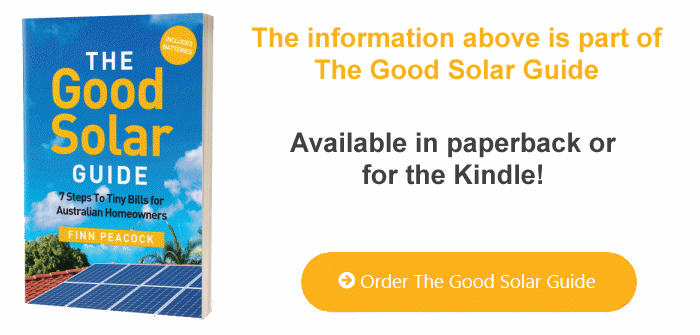Off-grid solar power
← Solar Power System Types | The Good Solar Guide Contents | Hybrid Solar Systems →
An off-grid solar power system is… drum roll, please… not connected to the grid. But you already knew that.
What you may not appreciate is that an off-grid system that will give a typical Australian home almost the same convenience as being on-grid will cost at least $40,000. Why so much? Because it needs to be designed to work even in the depths of winter when there is very little sun. This means it needs a much bigger solar panel array to generate as much power as possible in low light and to charge your batteries as well as powering your home. It also needs a large battery bank to store as much energy as possible for the gloomy days and to cope with any appliances that draw high power, even for short periods.
An off-grid solar power system is similar to an on-grid system, except that you need to add the following.
- A battery inverter: Like solar panels, batteries produce DC voltage. The battery inverter converts this to AC for your appliances to use. The battery inverter also houses the power electronics that constantly balance supply and demand in the stand-alone system.
- A battery bank: Any solar power generated above your appliances’ needs, instead of going to the grid, charges your batteries. Once the batteries are fully charged, the solar power is throttled back so as not to damage the batteries. This means that, most of the time, your solar panels are running way under their peak capacity – wasting solar energy, if you like. When your solar panels are not producing enough power, the appliances draw power from the batteries.
- A generator for backup: There will always be times when your batteries are drained and the sun refuses to come out. For these times, you need a backup generator.
Here are four reasons you might choose to go off-grid.
- There is literally no electricity grid where you live. Perhaps you live in the middle of the Simpson Desert like my Uncle Dave (seriously, he does!) or somewhere else equally remote. Hey, there’s no shortage of places like that in this big ol’ country of ours!
- There is a grid, but the nearest connection point is a long way from your home and your local electricity network wants to charge you an arm and a leg to connect you. In this case, it may be cheaper to go off-grid. Be aware, though, that a decent-sized off-grid system for a very efficient home is going to start at about $30,000.
- You are connected to the grid but you suffer frequent blackouts that cause you grief. You want a system that can run when the grid is down and you understand that a standard grid-connect solar system doesn’t work when there’s a power cut, unless it has a big and expensive battery backup system or a backup generator (or both).
- You’re crazy. Your house is already connected to the grid. Blackouts aren’t a problem (if they were, you’d already have a generator), but you just like the sound of going off-grid. You think it makes you more independent and protects you from the forthcoming apocalypse. In fact, you’ve already got a big shed to put the batteries in. It’s the same one where you stored all the canned food in readiness for the Y2K bug/end of the world last time round. You don’t mind spending $30,000 on an off-grid system that would only cost $6,000 if it were grid-connected. Or maintaining it much more frequently than a grid-connect system. Or buying new batteries every few years. Because you’re much closer to nature now you’ve cut that grid connection…
I guess what I’m trying to say is that unless 1, 2 or 3 above applies, it’s economically and environmentally insane to insist on an off-grid solar solution. It’s economically insane because the cost is three to five times higher. It’s environmentally insane because of all those batteries you’ll need to buy (and replace from time to time), which may contain nasty chemicals. Batteries also reduce the efficiency of your solar system. Expect them to lose 10% to 30% of all the energy stored. There’s also all the solar energy that’s wasted when your batteries are full. With no grid to absorb excess solar energy your solar panels will spend most of their time being throttled so they don’t overload your house and batteries.
Luckily, there’s a compromise: hybrid systems.
← Solar Power System Types | The Good Solar Guide Contents | Hybrid Solar Systems →
Questions or feedback about the content on this page? Contact me.
